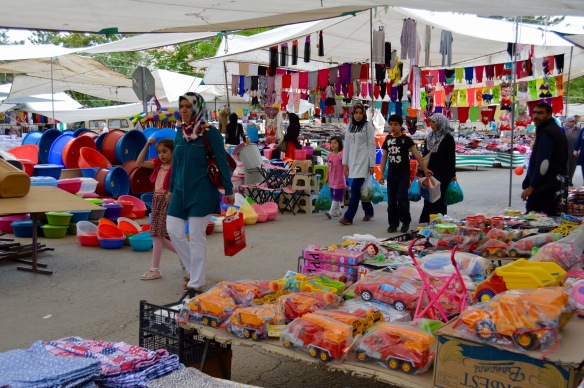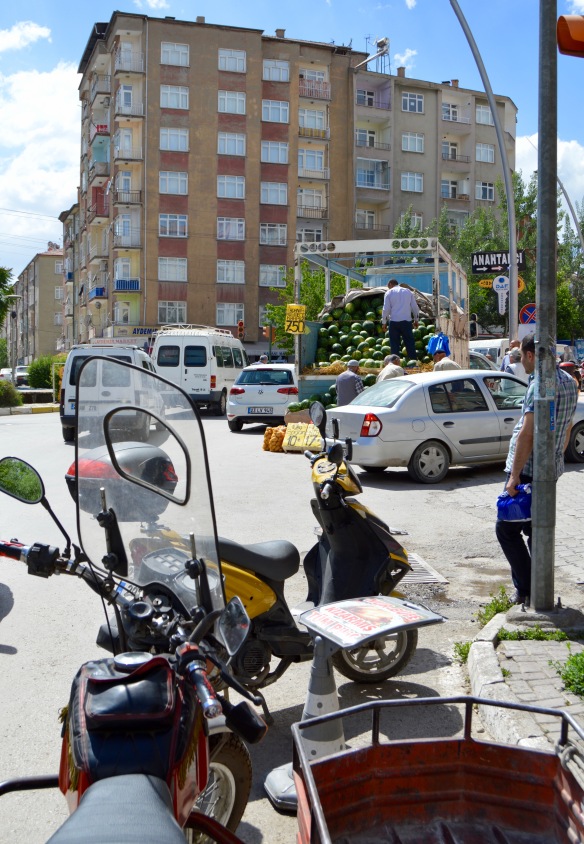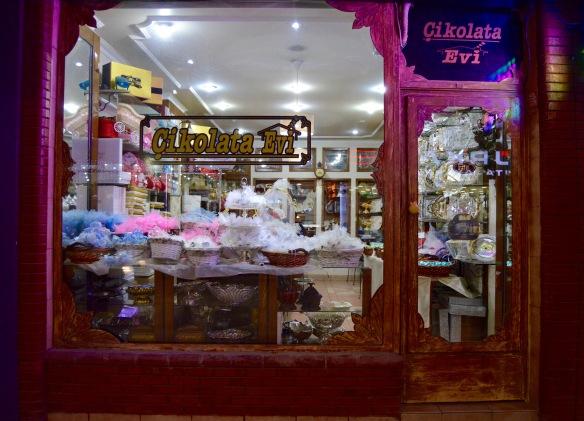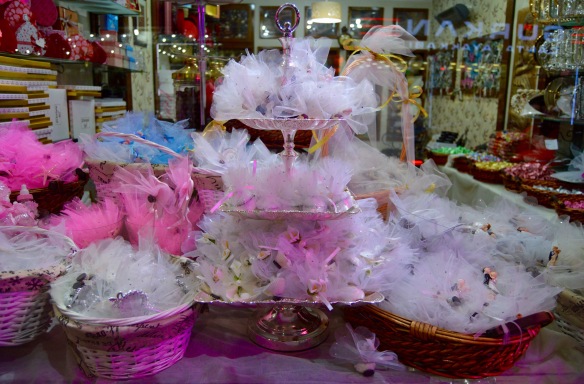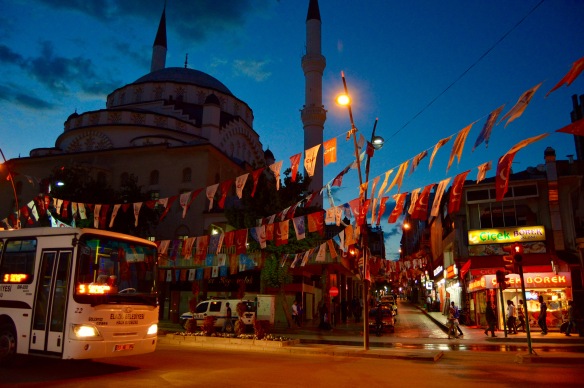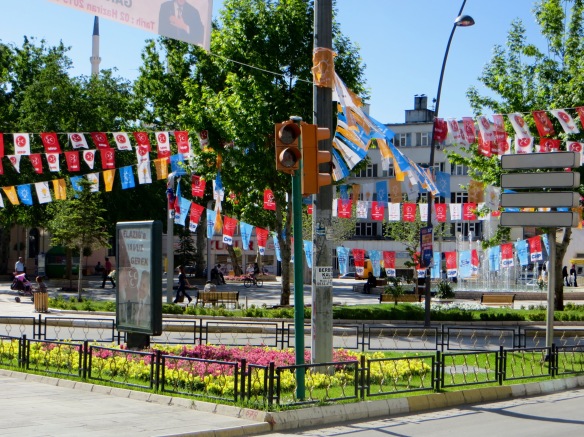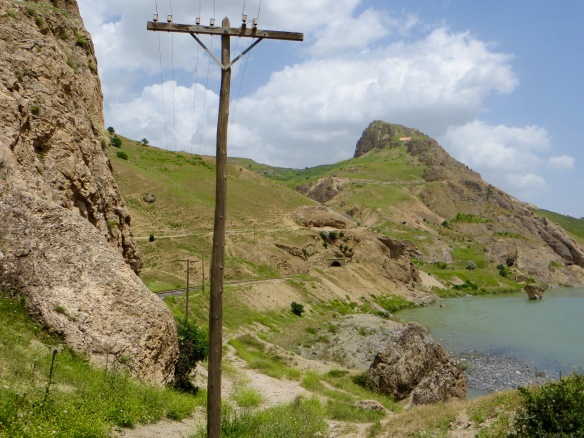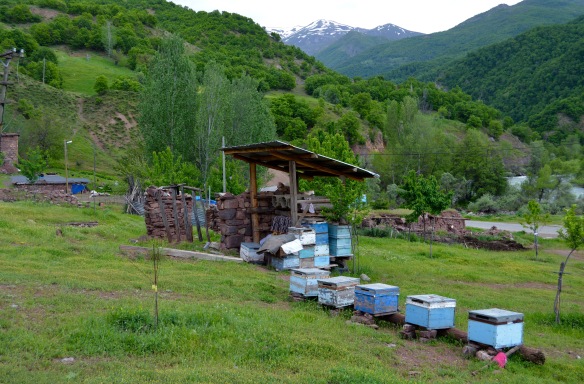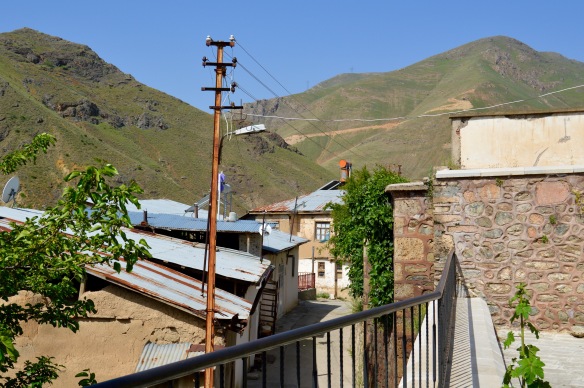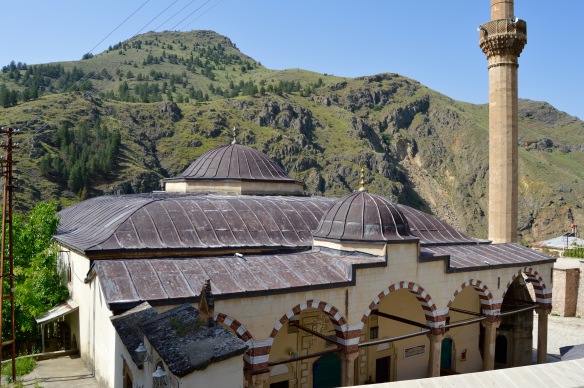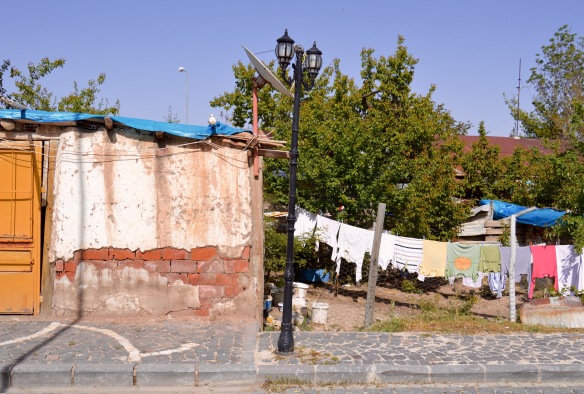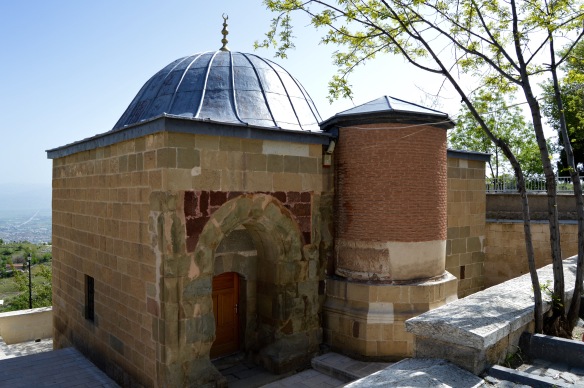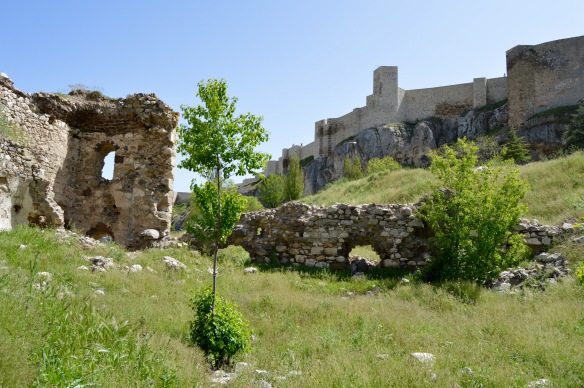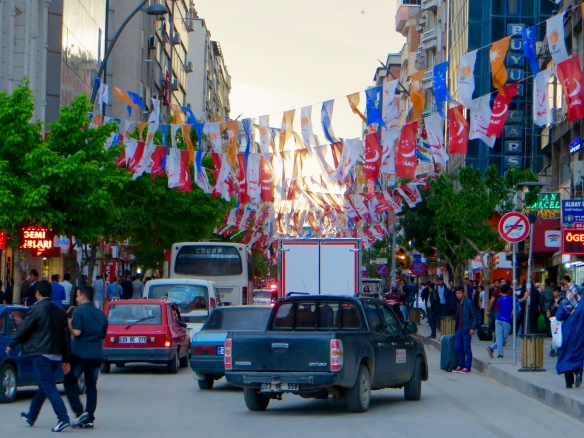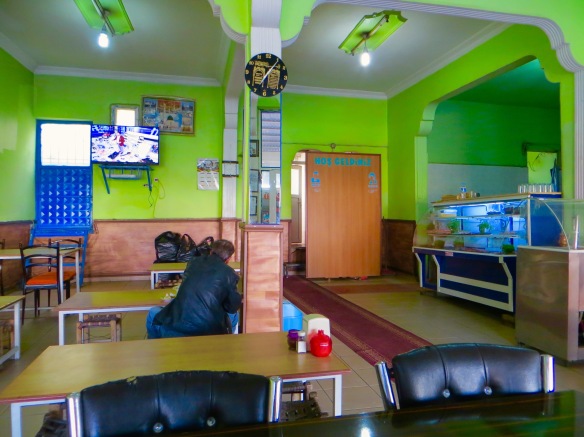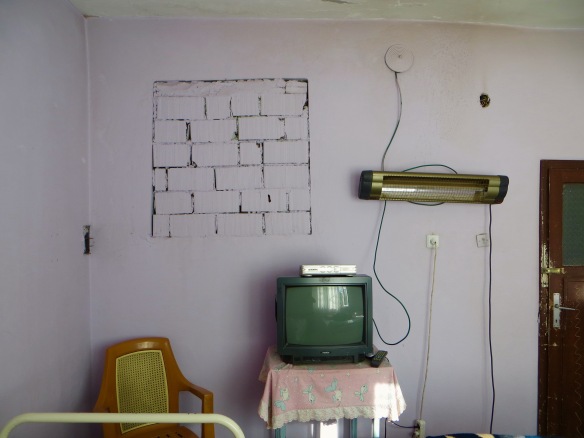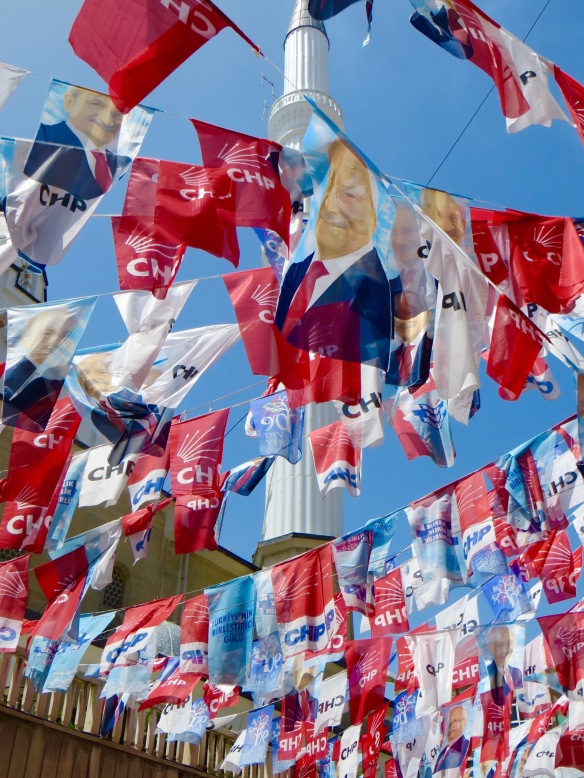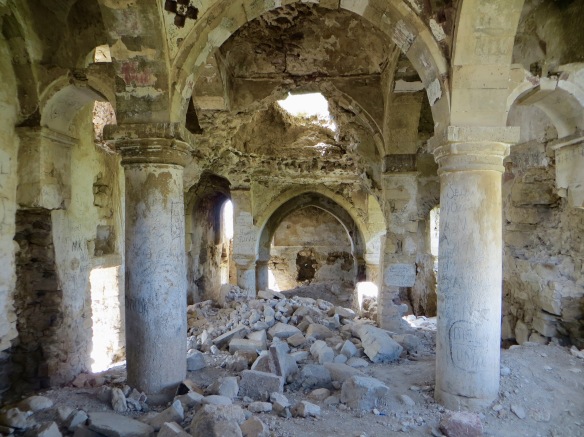The Mayd Hotel had two female staff, one who cleaned the rooms and got them ready for guests, and one who prepared breakfast and light snacks during the day. Both women, one of whom wore a headscarf, liked to smoke and were occasionally encountered sucking on cigarettes on balconies or in empty bedrooms. They worked harder than the males in the hotel, the owner himself and his four other employees. The latter shared duties on reception, carried guests’ bags to their rooms, assumed responsibility for the laundry and undertook odd jobs to ensure the smooth running of the hotel.
It was the last breakfast of the trip, so I went for broke. I had honey with yoghurt, borek, fried potatoes, grilled peppers, four types of olive, two types of cheese, tomatoes, boiled egg, simit, cherry jam, strawberry jam, melon, tea and water. I wanted to delay leaving the hotel for as long as I could so I had less time to spend in Diyarbakir, from where my flight was not scheduled to depart until just after midnight.
I went for a walk, calling first at the main square to examine for the last time the brightly painted buildings surrounding it and the bunting hung up by the different political parties. A block south of Gazi Caddesi was the street emerging as the place for up-market consumer goods including clothes, so I went there next to confirm that it aspired to be Elazig’s miniature version of Kensington or Knightsbridge in London. It did have aspirations to emulate Kensington or Knightsbridge, and every so often, I passed a new or yet-to-be-completed office or apartment block manifesting enviable attention to detail to make it look attractive. The more I walked around, the more the area looked as if it would emerge as an inner city middle class enclave where the devout and the secular lived together, but still somehow in parallel universes that never quite connected or interacted.
After walking past a small park sheltered by mature trees, I arrived at a sterile open space where buses arrived and departed for destinations around the city. I then entered what was overwhelmingly a residential area north of Gazi Caddesi, but small business premises were in most of the apartment blocks at street level. I zig-zagged north and east until arriving at a wide street running north to south where a narrow ribbon of greenery and a dry water feature turned the road into a dual carriageway. An attractive modern mosque overlooked the road from the west. In a shop window on the east side of the street, two women were making gozleme. The older woman had used a scarf to cover her face except for her eyes and the top of her nose, but the younger woman used her scarf to cover only her hair and ears. I wanted to take a photo of the two of them sitting on the floor as they rolled out the dough before cooking the gozleme on convex circles of sheet metal over a wooden fire, but could tell that they were reluctant to be immortalised, even though a man in the shop urged them to let me do so. I was on the Sunni side of the street and did not want to cause the women any embarrassment.
Once again, hypocrisy was writ large. Females from about the age of 14 or 15 were discouraged from having photos taken of them by anyone other than relatives or close family friends, but males of all ages urged you to take photos of them all the time, even if you had only just met them. When photography first became popular in Muslim societies, males and females were reluctant to be photographed because the rumour spread that the photo somehow captured part of a person’s soul and that the part of the soul thus captured would never return to the body which once possessed it. In time, however, males overcame their fear that part of their soul would be lost forever and allowed themselves to be photographed with ever greater enthusiasm. But females were still discouraged from being photographed, partly because of the ludicrous idea about the “theft” of part of the soul, but also because males did not want female family members to be looked at in photos by people who might have lustful inclinations toward them. That photos might be taken of Muslim males by photographers who had lustful inclinations toward them did not seem to count. As ever, therefore, females were required to inhabit the background while males got to strut their stuff.
I returned to the hotel to arrange things in my bags in such a way as to ensure the weight was as evenly distributed as possible, then showered, ate a peach given to me in Solhan, drank lots of water chilled in the bedroom fridge and went to reception to settle the bill. It was about 10.40am when I left the hotel and I arrived at the minibus garaj just in time to catch the 11.00am departure for Diyarbakir.
I could not recall the hills and mountains south of Elazig ever looking so pretty or so tempting to walk through. The visibility was excellent, so much so that my last day in Turkey was very good for photography, even though I was going south into less elevated surroundings on the last day of May when temperatures were definitely warmer than when I had started the trip. There were just enough white clouds to render the sky interesting and the clouds cast shadows over the fields, pasture, orchards, forests, hills and mountains. The mountains north and south of Hazar Golu still had smudges of snow on them, but they were smaller and fewer in number than two weeks earlier.
In Elazig, the railway station was conveniently located just a few blocks south of the main square, the otogar was not as far from the centre as in many cities of comparable size and even the airport was only 7 or 8 kilometres south-east of Gazi Caddesi.
At first, we followed the railway on its way to Palu, Mus and Tatvan, then that line veered off to the east as we went south to Hazar Golu. The Elazig to Diyarbakir railway left Elazig from the south-west, then swung to the south-east to take a route along the very sparsely populated south side of the lake. It was only when the road reached the east end of the lake and turned south-east for Maden that the railway and the road embraced each other so they could negotiate the direct but meandering route to Maden and Ergani.
The small town of Gezin was the last settlement the road passed through before leaving Hazar Golu. Most of Gezin comprised of villas that were the second homes for city slickers who loved the lake and its surroundings. A few businesses overlooked the main road and they were overlooked by a large modern mosque in the mock-Ottoman style with lots of domes and semi-domes of different sizes.
A short distance beyond Gezin, the hills and mountains embraced the road and the railway and the very pretty part of the journey to Maden began. Forest, pasture, beehives and villages on the valley walls added to the pleasure gleaned from watching the railway make progress south by means of short tunnels, bridges and cuttings. There were lots of yellow flowers, but for how much longer would they last? The deep red poppies of Dersim came to mind and I wondered how many were still looking their best. So delicate did they look that their petals reminded me of butterflies’ wings.
Just before Maden station, the minibus stopped at a roadside lokanta and small market where people were preparing gozleme and meat dishes such as patlican kebaps. A large pile of melons from Adana, some of the first such fruit of the year, were examined by families who had stopped in their cars. A white van hired by the HDP pulled into the car park and I chatted with its occupants. One of the occupants was a woman aged about 40 dressed in traditional Kurdish clothes. She was the same person who featured in a picture on the exterior of the van. She was going to Diyarbakir to take part in an HDP rally during which she would sing and dance. She was ready to go on stage as soon as she arrived at her destination.
As always, Maden’s location in a deep valley with houses stacked on the hillside above the railway and the river made me want to get out to look around, but I could not do so now with bags heavy with booty for home. Flights of stone and concrete steps meandered among the buildings to provide pedestrians with short cuts from one group of houses to the next. Shadows fell across the heaps of spoil that confirmed how important mining had once been. For a town with an official population of not much more than 5,000, Maden appeared to have a lot to offer its visitors.
Between Maden and Ergani, the bus boy brought everyone something to drink. I had a fruit juice.
Makam Dagi and the large cement works confirmed that we were approaching the northern edge of Ergani, from where the scenery took on a more worn-out appearance with rounded hills in the distance and the plain assuming the first shades of brown redolent of the long hot summer ahead. The road, a dual carriageway from Ergani almost all the way to Diyarbakir, allowed us to get to the northern suburbs of our destination very quickly, but it was then that we meandered through the extensive new suburbs to the main otogar dropping people off as we did so.
The meandering drive through the northern and western suburbs of Diyarbakir was other-worldly. Most of the buildings (the first few were encountered in ones and twos, but further into the city they clustered together en masse) were very new, very tall (blocks with at least ten storeys were many in number), carefully designed (balconies of generous proportions were commonplace) and brightly painted. Where such buildings clustered together they were invariably clones of one another, but there was something compelling about the views they created, despite being the opposite of all that I liked best about architecture in the Middle East (it was this alien character of the new suburbs that made them other-worldly). The buildings lay along new roads, some of which were wide and dominated by curves and roundabouts, the latter at intersections. Families wealthy by local standards occupied some of the apartments. The ground floors of many of the apartment blocks had businesses in them and, in time, the suburbs will emerge as places where local people can meet most of their routine needs without having to visit the city centre. Some of the most impressive businesses were large lokantas and cafés with ultra-modern air conditioned interiors and outdoor patios raised above the level of the pavement. Family groups sat on the patios enjoying a very late breakfast or very early lunch (some such groups may have been eating brunch. The suburbs were not without their American characteristics). Blink and the suburbs of Diyarbakir could have been in parts of Mediterranean Europe. Moreover, it was obvious that some of Diyarbakir’s best dining experiences were now in the suburbs and not in the old city or the streets immediately enclosing it.
The benefits of the peace that had prevailed in the south-east for some years impressed themselves in a manner as substantial as that of the Syriac Orthodox Christians who had returned to the Tur Abdin region around Mardin and Midyat.
Inevitably, not everywhere surrounding the apartment blocks and other large structures such as offices and shopping malls had been landscaped, with the result that many families and office workers overlooked patches of open space marred with litter and the debris of construction work. In time, of course, such open spaces will be built over or turned into parkland and/or playgrounds, and very large billboards had artists’ impressions of what the brave new world will eventually look like. My heart inclined for obvious reasons toward the old city, despite its considerable challenges in terms of overcrowding and economic decline, but I could see the appeal of Diyarbakir’s new suburbs, especially for Kurds in the region who, for the first time ever in many families, were encountering economic security and well-being.
We arrived at the newish otogar, itself increasingly enclosed by the brave new world of wide boulevards and large structures with brightly painted walls, and some of us transferred to a servis bus that took us to the edge of the old city through streets busy with pedestrians and motorised traffic.
I had a cunning plan. I would identify a small hotel where rooms came with en suite facilities where I could leave my bags and wash and rest when I wanted, then check out at about 9.45pm. With the temperature about 30 degrees centigrade and likely to rise another degree of two by 4.00pm, I knew I could not get to the airport feeling and looking presentable without at least one shower. I also wanted to have a good look around the old city, which would inevitably mean I would get a bit grubby. I found just what I wanted between Kibris Caddesi and Inonu Boulevard. Moreover, the hotel was about 150 metres from where taxis left for the airport for a very reasonable flat fare.
I showered and changed into grubby but still presentable clothes to keep clean the clothes I had travelled in from Elazig (the clothes worn in Elazig and to Diyarbakir I would put back on for the journey home), then set off for the trip’s final good look around. Surp Giragos Church was my first destination. I made my way via the narrow streets of the old city east of Gazi Caddesi and south of Biyikli Mehmet Sokak.











